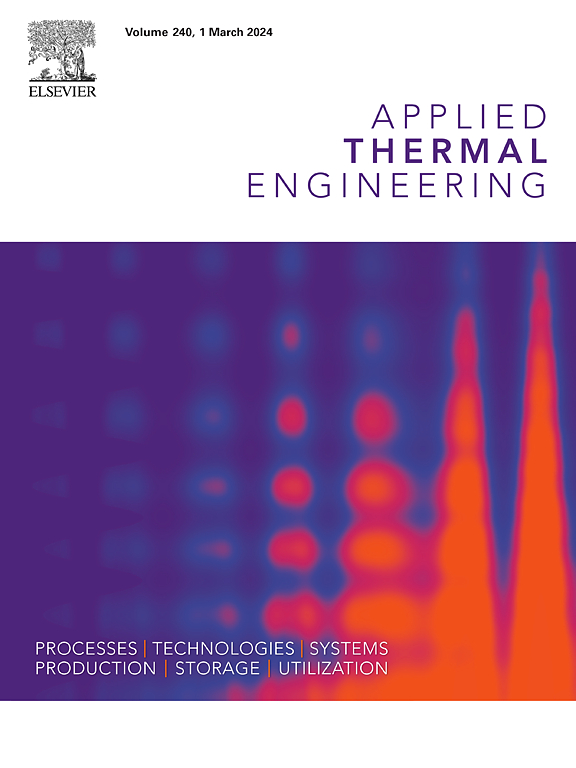微胶囊相变材料浆料在波浪形微通道中流动的热特性和流体力学特性
IF 6.1
2区 工程技术
Q2 ENERGY & FUELS
引用次数: 0
摘要
微胶囊相变材料浆液(MPCS)是一种性能良好的新型冷却流体。本研究以数值方法研究了 MPCS 在波浪形微通道内的传热和流动特性。MPCS 被模拟为均质牛顿流体。在雷诺数为 50 到 250(层流状态)的范围内,研究了五种波浪形几何形状,其振幅和波长各不相同。模型结果表明,随着雷诺数的增加以及波浪形微通道振幅和曲率半径的减小,压降和努塞尔特数也随之增加。此外,结果还显示,随着波幅和雷诺数的增大,迪恩涡旋会增强。相反,随着通道波长和曲率半径的增加,这些漩涡会减弱。迪恩涡流的形成加强了流体混合,从而改善了浆料的热性能。研究得出结论,在采用 MPCS 的波浪形微通道中,提高雷诺数、增加通道相对于波长的振幅和减小曲率半径可改善整体性能。结果还显示,在雷诺数较高的情况下,曲率半径是对波浪形微通道整体性能最有效的参数。本文章由计算机程序翻译,如有差异,请以英文原文为准。
Thermal and hydrodynamic characteristics of microencapsulated phase change materials slurry flow in wavy microchannels
Microencapsulated phase change material slurry (MPCS) is a novel cooling fluid with promising performance. This study numerically investigates heat transfer and flow characteristics of MPCS within wavy microchannels. MPCS is modeled as a homogeneous, Newtonian fluid. Five wavy geometries were examined across a Reynolds number range of 50 to 250 (laminar flow regime), varying in amplitude and wavelength. The model results show that with increase in Reynolds number and decrease in the amplitude and radius of curvature of wavy microchannels, the pressure drop and Nusselt number also increase. Furthermore, the results reveal that Dean vortices intensify with increasing wave amplitude and Reynolds number. Conversely, these vortices weaken as channel wavelength and radius of curvature increase. The formation of Dean vortices enhances fluid mixing and consequently improves the thermal performance of the slurry. The study concludes that in wavy microchannels employing MPCS, increasing the Reynolds number, increasing the channel amplitude with respect to wavelength, and decreasing the radius of curvature improves the overall performance. Also, the results reveal that in higher Reynolds numbers, the radius of curvature is the most effective parameter on the overall performance of wavy microchannels.
求助全文
通过发布文献求助,成功后即可免费获取论文全文。
去求助
来源期刊

Applied Thermal Engineering
工程技术-工程:机械
CiteScore
11.30
自引率
15.60%
发文量
1474
审稿时长
57 days
期刊介绍:
Applied Thermal Engineering disseminates novel research related to the design, development and demonstration of components, devices, equipment, technologies and systems involving thermal processes for the production, storage, utilization and conservation of energy, with a focus on engineering application.
The journal publishes high-quality and high-impact Original Research Articles, Review Articles, Short Communications and Letters to the Editor on cutting-edge innovations in research, and recent advances or issues of interest to the thermal engineering community.
 求助内容:
求助内容: 应助结果提醒方式:
应助结果提醒方式:


